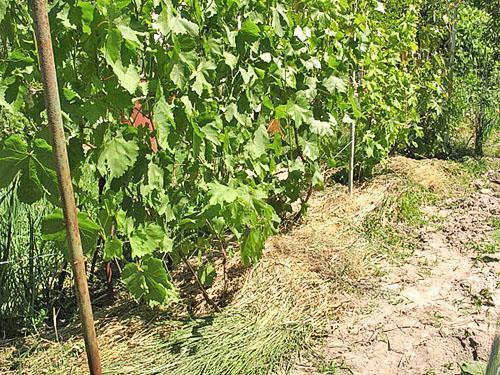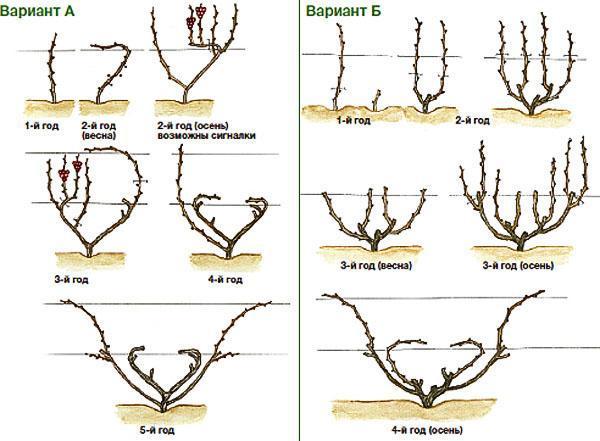Good vine care is a guarantee of a rich harvest
 In order to get large bunches of tasty grapes in the fall, systematic care, feeding and protection of the plant from pests should be carried out during the development of the bush. With the experience of cultivation, knowledge of the basic rules and increasing the yield of the plantation and the formation of the vine comes.
In order to get large bunches of tasty grapes in the fall, systematic care, feeding and protection of the plant from pests should be carried out during the development of the bush. With the experience of cultivation, knowledge of the basic rules and increasing the yield of the plantation and the formation of the vine comes.
The structure of the bush and the purpose of forming the crown

 The goal of vines formation is to achieve productivity. That is, the nutrition of the bush should be aimed at obtaining berries. To obtain a high-quality harvest, it is required to leave as many ovaries on the bush as the plant will feed and bring to a mature state. Therefore, during the season, in addition to watering, fertilizing and processing, it is required to form a bush so that each leaf is illuminated and worked for the harvest.
The goal of vines formation is to achieve productivity. That is, the nutrition of the bush should be aimed at obtaining berries. To obtain a high-quality harvest, it is required to leave as many ovaries on the bush as the plant will feed and bring to a mature state. Therefore, during the season, in addition to watering, fertilizing and processing, it is required to form a bush so that each leaf is illuminated and worked for the harvest.
Pruning grapes and caring for the vine
In different periods of development, pruning and pinching of the lashes performs different tasks. Usually work takes place in three stages:
- pruning grapes in spring;
- green operations;
- autumn pruning of grapes.
If you do not prune, pinch the bush regularly, it runs wild, the yield decreases. However, in some cases, the bush is formed according to its requirements. For a decorative bush, the vine may not shorten and twine around the frame of the shelter, but then the harvest on it will be a secondary, not the main factor.
Pruning the vine in spring
 Pruning grapes in the spring, after removing the winter shelter, it consists in revising the overwintered vine. At this time, the condition of the overwintered bush is assessed. Even before the start of sap flow with sharp tools and special techniques, the sleeve is formed and the vine is prepared. Here, the removal of weak shoots is carried out; in the first years of the development of the trunk, sleeves are formed on which vines grow in the future. The task of the master is to correctly cut and shape the plant so as not to disrupt the path of sap flow from the sleeve to the vine.
Pruning grapes in the spring, after removing the winter shelter, it consists in revising the overwintered vine. At this time, the condition of the overwintered bush is assessed. Even before the start of sap flow with sharp tools and special techniques, the sleeve is formed and the vine is prepared. Here, the removal of weak shoots is carried out; in the first years of the development of the trunk, sleeves are formed on which vines grow in the future. The task of the master is to correctly cut and shape the plant so as not to disrupt the path of sap flow from the sleeve to the vine.
 At the same time, the entire state of the bush is assessed for winter preservation. Depending on the degree of freezing, a stem is formed.
At the same time, the entire state of the bush is assessed for winter preservation. Depending on the degree of freezing, a stem is formed.
When performing spring pruning of grapes, it must be remembered that this is a surgical operation on a tree, therefore, you should work with disinfected instruments, and make wounds sparing.
After the shoots begin to appear on the branches, the strongest are left and one by one, the rest all break out. From the very beginning, a bush is formed with the optimal number of branches, which should have enough lighting and nutrition.
Summer vine care
 Gardeners know how to form a vine correctly from experience. It is believed that you need to know the characteristics of each plant and talk to it during work. Formation work consists of the following operations:
Gardeners know how to form a vine correctly from experience. It is believed that you need to know the characteristics of each plant and talk to it during work. Formation work consists of the following operations:
- pruning the vineyard in June;
- pinching the trunk;
- regulation of brushes;
- chasing vines.
 Pruning grapes in the summer after flowering is about harvest regulation.The fewer brushes the vine feeds, the fuller and tastier they will be. It is necessary to find a balance so as not to overload the bush and get a good harvest. Harvest formation comes with the experience of crop management.
Pruning grapes in the summer after flowering is about harvest regulation.The fewer brushes the vine feeds, the fuller and tastier they will be. It is necessary to find a balance so as not to overload the bush and get a good harvest. Harvest formation comes with the experience of crop management.
The harvest is normalized again after the formation of the brushes, leaving one or two very first brushes with poured berries on the shoot. In this case, small ovaries are removed. The procedure is done at a time when the berries are still pea-sized.
At the end of June, the shoots are shortened by pinching, leaving five leaves above each bunch of grapes, which is enough to form a crop. At the same time, remove all stepchildren appearing in the leaf axils, leaving only those that are required for the formation of the vine in summer. In June, the ends of the vine are pinched to limit its growth. In this case, most of the food will be redistributed to the filling of grapes. However, those young shoots that grow for replacement are not shortened.
There is always a garter of shoots throughout the summer to the trellis for grapes, after they have grown over the lower tier of the wire by more than 20 cm. In this case, the condition of illumination of each leaf is observed. The grower considers the most important in crop management to regulate the green mass, watering and feeding the plant at the time.
 Another agrotechnical technique that accelerates the maturation of brushes is vine chasing. This means that all the tops of the left shoots are removed, leaving 13-15 leaves. In these conditions, the intensive development of stepchildren begins in the leaf axils. Stepsons should be removed regularly. The video set at the end of the article will help you master the basic techniques of minting grapes in summer.
Another agrotechnical technique that accelerates the maturation of brushes is vine chasing. This means that all the tops of the left shoots are removed, leaving 13-15 leaves. In these conditions, the intensive development of stepchildren begins in the leaf axils. Stepsons should be removed regularly. The video set at the end of the article will help you master the basic techniques of minting grapes in summer.
 Among winegrowers there are also opponents of the use of coinage. They point to the fact that growing without the use of vine shortening promotes root growth. They argue that the plant is less sick and the berries are tastier. However, disputes are only possible in relation to vineyards cultivated without shelter. For stemless varieties, the formation of the vine in the summer is mandatory.
Among winegrowers there are also opponents of the use of coinage. They point to the fact that growing without the use of vine shortening promotes root growth. They argue that the plant is less sick and the berries are tastier. However, disputes are only possible in relation to vineyards cultivated without shelter. For stemless varieties, the formation of the vine in the summer is mandatory.
Top dressing and processing of grapes
At the same time, nitrogen fertilization is excluded in the second half of summer, and the growth of greenery slows down. Phosphorus-potassium nutrition continues, it improves the filling, the taste of the grapes and increases the winter hardiness of the culture. Ash feeding of the trunk is especially appreciated.
For better illumination of the bush, which is already beginning to lose its strength by the rays of the sun, three weeks before harvesting, part of the leaves from the vine is removed, giving maximum illumination to the bunches. Leaves at the bottom of the bush and from the bunches must be removed. Airing will exclude the possibility of fungal diseases, which are especially widespread during the nighttime cold snap and growing.
Vine care would be incomplete if it did not include activities such as controlling fungal diseases and insect pests. TO grape diseasesthat can destroy him include oidium and mildew. Therefore, if a characteristic plaque or spots appear on the leaves on the back side, it is necessary to treat with fungicides. Most often, preventive treatment with Topaz is carried out.
Insect pest grape mite is removed with insecticidal preparations. However, three weeks before harvesting, any processing is prohibited. During the season, preventive treatments of the vineyard are carried out three times. In the event of the first signs of fungal diseases, the entire garden is treated.
How to prune grapes in the fall
 Autumn care for a vine consists in properly preparing it for wintering. How to prune grapes in autumn and prepare the vine for wintering in each climatic region is decided differently. Non-standard bushes require preparation of the vine during the period when the leaves fall off. Then they cut out all weak shoots, remove their young green parts.The vines are carefully removed from the supports, tied in bunches and placed in specially prepared grooves. In this tubule covered with peat, foliage and soil vines will wait until next year to repeat the life cycle.
Autumn care for a vine consists in properly preparing it for wintering. How to prune grapes in autumn and prepare the vine for wintering in each climatic region is decided differently. Non-standard bushes require preparation of the vine during the period when the leaves fall off. Then they cut out all weak shoots, remove their young green parts.The vines are carefully removed from the supports, tied in bunches and placed in specially prepared grooves. In this tubule covered with peat, foliage and soil vines will wait until next year to repeat the life cycle.